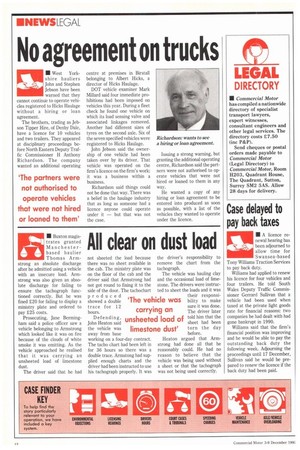All clear on dust load
Page 14

If you've noticed an error in this article please click here to report it so we can fix it.
• Buxton magistrates granted Manchesterbased haulier Thomas Armstrong an absolute discharge after he admitted using a vehicle with an insecure load. Armstrong was also given an absolute discharge for failing to ensure the tachograph functioned correctly. But he was fined £20 for failing to display a ministry plate and ordered to pay £25 costs.
Prosecuting, Jane Bermingham said a police officer saw a vehicle belonging to Armstrong which looked like it was on fire because of the clouds of white smoke it was emitting. As the vehicle approached he realised that it was carrying an unsheeted load of limestone dust.
The driver said that he had not sheeted the load because there was no sheet available in the cab. The ministry plate was on the floor of the cab and the driver said that Armstrong had not got round to fixing it to the side of the door. The tachochart produced showed a double trace for 12 hours.
Defending, John Heaton said the vehicle was away from base working on a four-day contract. The tacho chart had been left in for 36 hours so there was a double trace. Armstong had supplied enough charts and the driver had been instructed to use his tachograph properly. It was the driver's responsibility to remove the chart from the tachograph.
The vehicle was hauling clay and the occasional load of limestone. The drivers were instructed to sheet the loads and it was their responsibility to make sure it was done. The driver later told him that the sheet had been torn the day before.
Heaton argued that Armstrong had done all that he reasonably could. He had no reason to believe that the vehicle was being used without a sheet or that the tachograph was not being used correctly.












































































